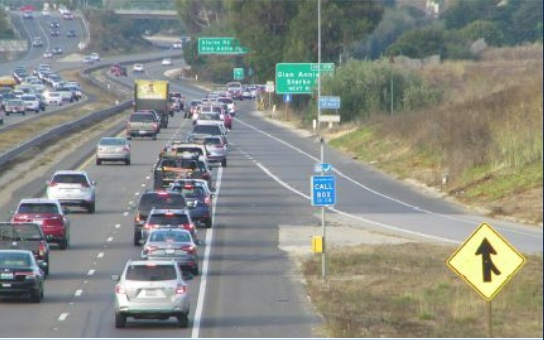Housing and Traffic Snarls Goleta and County of Santa Barbara
City Protests County Planning Idea to Fudge on Traffic Impacts of Thousands of New Homes

Knitted up in the Housing Element is the possibility that local rules — like traffic congestion rules — could make a project fall afoul of the state authorities, observed County Planning and Development recently, suggesting a work-around. The City of Goleta disagrees. Thousands of new homes use city roads and intersections, and the standards to deal with traffic impacts should not change, the City Council emphatically stated on Tuesday. “The county is essentially washing its hands of any responsibility,” Councilmember Luz Reyes-MartÍn put it succinctly.
For Goleta, that Glen Annie’s 1,000 homes and South Patterson’s 1,422 homes — numbers from the current county Housing Element map — could be zoned into existence atop recreation and agriculture lands is already painful. But that a developer’s obligation to mitigate traffic impacts would be a judgment call by County Public Works is unfathomable. Traffic to and from Dos Pueblos High School and Camino Real Marketplace make Glen Annie, Cathedral Oaks, Storke, Calle Real, and Highway 101 back up regularly. At South Patterson, the avocado and lemon orchard owned by the Giorgi family may add another 1,253 homes to the county, just east of where Goleta is attempting to make Old Town more walkable by reducing vehicle traffic.
What county P&D wants to avoid are barriers to housing, said County Planning Director Lisa Plowman, that could reduce the housing count. “What we’ve tried to do is get ahead of this problem” of an intersection where improvements can’t be made because of land constraints, or because it makes a project too costly, or for other reasons, she explained.
“Developers would be held to preparing a traffic study and identifying the issues,” Plowman said. But the proposed amendment would allow Public Works’ traffic engineers to figure out needed improvements with the developer, rather than using objective standards of congestion to require them. From P&D’s point of view, this would enable the county to keep these rezoned projects counted in the state-mandated housing numbers known as RHNA (regional housing needs allocation). If the county falls short, it risks losing access to large pots of state funding.
Goleta has had its own issues with the Housing Element. The city submitted its version complete with rezones on time but under withering neighborhood objections over these same roads and intersections.
“We understand the traffic challenges that accommodating state-mandated RHNA in this housing cycle entails,” Goleta planning director Peter Imhof wrote in an email. “However, by contrast, the city believes the more responsible course is to keep its General Plan LOS [level of service] standards and apply them as rigorously as possible to Housing Element projects and to work cooperatively and constructively with neighboring jurisdictions to find solutions.”
At Tuesday’s council meeting, several councilmembers expressed concerns for safety if intersections were left with lower standards. If fully built out to its potential housing, South Patterson would be the fifth largest city in the county, Councilmember James Kyriaco recalled hearing at the County Planning Commission meeting on the rezones in March, which is where this new amendment first appeared. “We’d do all the services, we’d get all the impacts, they’d get all the property tax,” Kyriaco stated. He concluded by saying he hoped the county would be willing to recognize the impacts as well as provide much-needed housing.
County Supervisor Laura Capps, in whose 2nd District the giant South Patterson projects fall, had voted against approving the county’s Housing Element, in part because of the concentration in the Eastern Goleta Valley. “I share their concern,” she said of Goleta’s objection to the traffic assessment changes.
Since arriving in office about a year ago, Capps said she’d felt the pressure to move fast on the Housing Element. “I am a fierce advocate for more affordable housing,” she said,” but this is exactly the concern — undue concentration in one community and the serious impacts that has on traffic, water, and density.”
Capps noted that she and Supervisor Joan Hartmann, in whose 3rd District the Glen Annie project falls, were able to add 320 units at two county-owned sites to this cycle’s report and hope to add more. “We’ll need those in the event we don’t reach our affordable numbers,” said Capps, as this housing cycle proceeds, which requires updates on housing production every two years.
In Plowman’s eyes, South Patterson has all the right stuff. “It’s near schools and employment, and people will have better luck with alternative forms of transportation there,” Plowman said, referencing the bus lines on Hollister and the bike lanes along Atascadero Creek.
Goleta’s is not the only letter the county has received. YIMBY, a public-interest group intent on affordable housing in California, sent a letter to the county that opines that the county missed its rezone obligation deadline and is not in compliance in its Housing Element. The letter, which alternately praises and threatens, states YIMBY will call on the state to revoke the compliance if the county doesn’t complete its rezoning by June. The Board of Supervisors takes up the rezones on April 30 and May 3.
